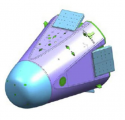Old post below on the DF-26 submunitions and large aircraft on Guam
If we take a really large base like Guam with 2 runways as an example, a back of the envelope calculation indicates there is a perimeter encompassing 3,200,000m2 where aircraft could be parked.
A 17gram tungsten ball bearing travelling at Mach 5 has the same energy as a M77 cluster bomblet.
So a 300kg warhead on a single ballistic missile could carry 18000 ball bearings.
Theoretically, a single missile payload could cover the entire airbase, with a ball bearing hitting every 177m2.
A large bomber like the B-2 has a wing area of 478m2.
A tanker like the KC-46 has a wing area of 283m2 plus fuselage.
So we could typically expect 2 ball bearings to hit each large aircraft.
And you only need to do this once a day.
Smaller fighter jets fare better because of the smaller wing area.
But if China/US/Japan are all restricted from using large aircraft, that suits the Chinese military just fine.
China can achieve its objectives just with small aircraft, whilst USA/Japan are dependent on bombers and tankers, if they want to block the Chinese from achieving their objectives.
---
This is part of why I think Chinese military objectives can mostly be achieved with land-based missiles and aircraft.
And that building a large fleet of aircraft carriers for blue-water operations can wait.

